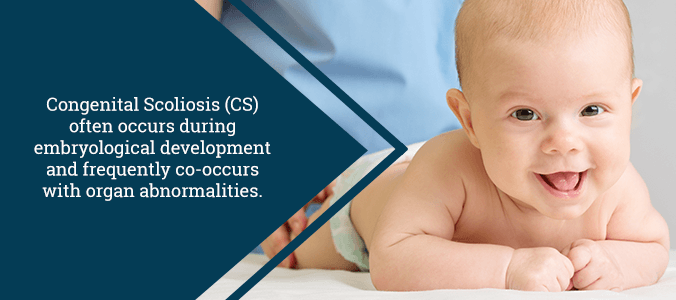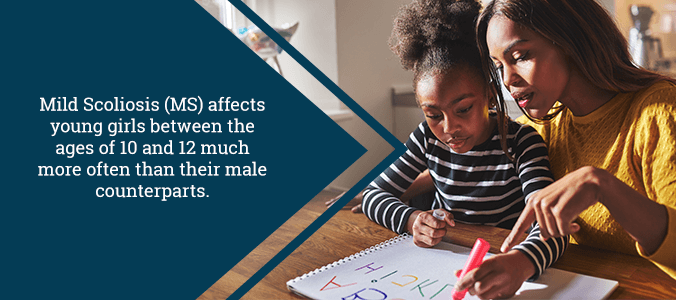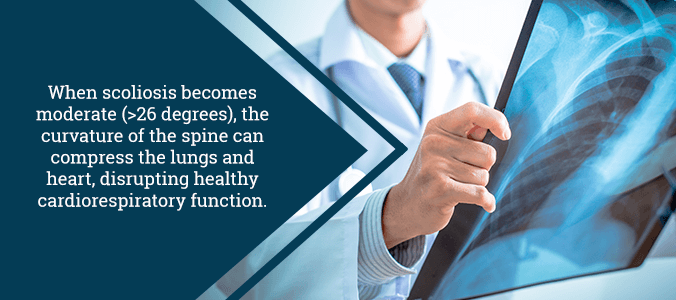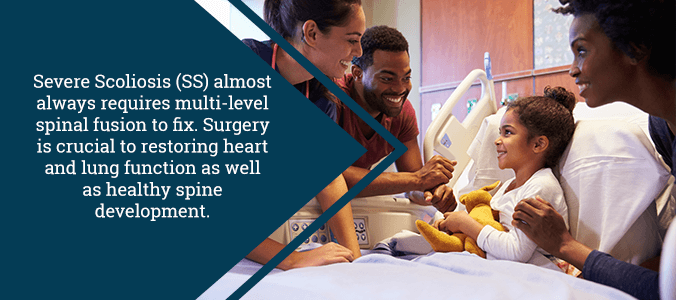Symptoms of Scoliosis: Mild, Moderate, & Severe
Scoliosis describes a condition in which the patient has an abnormal curvature of the spine. This curve is a three-dimensional deformity, in that the spine curves laterally or from side-to-side. Despite this fact, scoliosis often appears as a simple “C” or “S” shape in x-ray images.
This condition can occur at different areas in the spine. These areas include: the cervical (neck) spine, the thoracic (middle) spine, and the lumbar (lower) spine. In some cases, scoliosis affects more than just one of these areas at a time.
Although no two cases are the same, there are general patterns of scoliosis that are more common than others. Generally speaking, in about 80-85% of scoliosis cases, the cause of the condition cannot be identified. These cases are called idiopathic scoliosis (cases in which the cause of scoliosis is unknown). Depending on when the onset occurs, idiopathic scoliosis breaks down into subcategories: infantile, juvenile, adolescent, or adult.
Additionally, scoliosis breaks down even further into classifications such as neuromuscular or congenital. With neuromuscular scoliosis, a condition such as cerebral palsy or muscular dystrophy develops first. Once these conditions are present, scoliosis can occur as a secondary symptom. On the other hand, congenital scoliosis (CS) occurs during embryological development. And, (CS) commonly occurs with other organ anomalies.

Degrees of Scoliosis
There are three forms of scoliosis: mild, moderate, and severe. They each have different levels of risk progression and are treated on a case-by-case basis. Furthermore, scoliosis is hard to detect in its early stages. More often than not, the subtle symptoms are dismissed until a rapid growth spurt causes the spinal curvature to worsen.
Mild Scoliosis (MS)
- Risk of progression can be up to 22%
- Curve is less than 25 degrees
- Once the curve passes 20 degrees, the risk of progression skyrockets up to 68%
- The patient may have uneven shoulders or hips and a tilted head
- The patient may appear as if they are permanently slouching (forward head posture)
- Clothing may appear to hang unevenly when worn
- The patient may have uneven leg lengths
- This form of the condition often goes unnoticed
- The patient may or may not experience pain
- This form of the condition commonly occurs in young, premenstrual girls (although it can also occur in adults or boys)
(MS) is easiest to overcome when the curve is small. In most cases of (MS), the main concern is the cosmetic deformity. But, sometimes pain can occur as well. A doctor may use a scoliscore test or x-ray imaging to determine the likelihood of progression. Depending on the patient’s case, a doctor may consider surgery, but more conservative treatments are usually considered first. Surgical treatments for (MS) have come a long way and can be treated with minimally invasive spinal fusions.

Moderate Scoliosis (MoS)
- Spinal curve is 26-40 degrees
- (MoS) has a 68% chance to progress
- The patient may have uneven shoulders or hips and a tilted head
- The patient may appear as if they are permanently slouching
- Clothing may appear to hang unevenly when worn
- Patient’s with (MoS) often have rib humps
- The patient may or may not experience pain
- Physical activity easily leads to fatigue
- The patient often appears clumsy
- The patient may feel pain at the base of the rib cage and at the shoulders
- Headaches are common in patients with (MoS)
- Braces are often used to treat (MoS)
(MoS) is easiest to treat before the curve becomes severe. It is important to stop progression before the curve gets worse. More often than not, treatment allows more room for the organs as well as increased lung capacity. Patients find that after treatment they feel as though they have more energy for day-to-day tasks. For (MoS) curves, doctors most commonly use scoliosis braces for treatment. That being said, recent studies question the effectiveness of braces for (MoS). Occasionally, braces can cause an increase in rib cage deformity (rib hump). Braces can be effective at halting progression before the curve reaches 50 degrees. If the condition progresses past that point, however, your doctor will likely suggest surgery. In such a case, spinal fusion surgery is the most common procedure.

Severe Scoliosis (SS)
- Spinal curve is above 40 degrees
- (SS) has a 90% chance to progress
- May have uneven shoulder or hips and a tilted head
- Spine may appear to have a “S” or “C” shape underneath the skin
- The patient’s belly button may appear off center
- The patient’s clothing may appear to hang unevenly when worn
- The patient with (SS) has prominent rib humps
- Easily fatigued by physical activity, as well as long periods of standing or sitting
- The patient often appears clumsy or accident-prone
- Patients with (SS) are more likely to experience pain at the base of the rib and between the shoulder blades
- Headaches are common in patients with (SS)
- Doctors often suggest surgery for (SS) patients

(SS) is the worst form of the condition and should not be taken lightly. Patients with spinal curves beyond 40 degrees are usually treated surgically with multiple level spinal fusion. Although there are always risks associated with any surgery, (SS) surgery has improved over the past several decades. There are plenty of minimally invasive alternatives available now that are often used before traditional open surgery treatments. Treatment can alleviate chronic pain, headaches, digestive orders, and loss of balance. Many patients with (SS) often struggle with depression, social anxiety, and poor body image.
If you or your child is suffering from a spinal deformity, then please contact us. You can schedule an appointment online or by phone at (855) 220-5966. Dr. Jason Lowenstein and his team of experts deliver award-winning services throughout New Jersey. For a personalized treatment plan and the latest minimally invasive care, contact Dr. Jason Lowenstein today!
